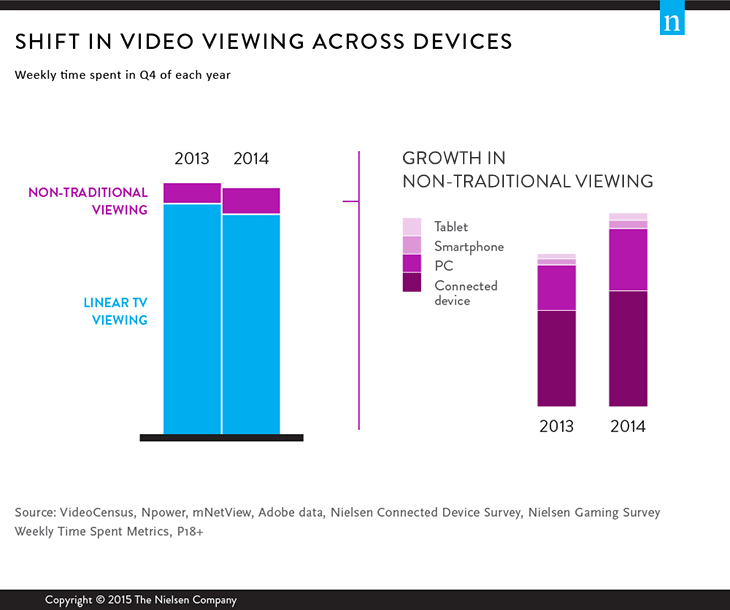At Nielsen, we view Total Audience as a framework for measuring ads and content regardless of the platform on which they are viewed. The goal, of course, is to provide the industry with an expansive set of measurements to support whatever new currency or currencies emerge from what we expect to be a period of healthy debate.
Let me start with the changes under way, which are illustrated in this exhibit:

Total video viewing is flat. Live and time-shifted TV still represent a very large percentage of viewing minutes, so measurement of the Total Audience must include the C3 and C7 ratings. But this percentage is changing as consumers move across platforms, across time and across ad models.
So let’s look at the viewing happening on digital and connected device content today. A very large amount of this is non-ad-supported SVOD (subscription-based video on demand) viewed on the TV screen. Viewing of video via digital devices is predominantly happening via PC, but tablets are on the rise. It’s important to remember that viewing also includes “digital first” content—including, for instance, YouTube, Facebook and AOL.
As the industry evolves, so does the need for an industry standard that represents all of this viewing. Total Audience is a framework that captures how we are responding to that—a way of following the consumers so that our measurement captures what everyone is watching wherever and whenever they’re watching it.
So why isn’t all of this viewing in the ratings today? Back in November of last year, we put out a call to action to the industry to review the C3/7 definitions to allow for the inclusion of more of this viewing into the ratings. Given that context, it’s important to understand what C3/7 is and what it isn’t.
The C3/7 definitions were agreed in 2006 by the buyers and sellers in the marketplace, who established a set of eligibility criteria for inclusion in the official ratings numbers.
C3/7 is a measure of the average viewing for commercial minutes in live programming plus playback by DVR for three or seven days afterwards—i.e., a rating for the ad load. This measurement includes all viewing of the telecast of a program over three and seven days that fits three criteria: It must be TV originated content (so it does not include digital-first content); the ad load must be the same, meaning no changes can be made to the ads and the order in which they appear during that three- or seven-day window if the viewing is to be included; and it must be identifiable by a watermark.
What this measurement doesn’t include is a lot of the viewing now growing—time shifting beyond seven days, viewing with changes in ad load (whether due to dynamic insertion or precision-advertising), viewing that doesn’t contain ads, and viewing that doesn’t contain watermarks—in short, anything that is not TV-originated.
Recognizing that these limitations would eventually make the ratings insufficient, we created the Total Audience framework in order to offer a larger set of comparable metrics across a broader viewing spectrum, thus offering flexibility in what the market chooses to trade on. This will ultimately result in the updating of the ratings definitions to include more viewing.
Creating Total Audience measurement requires us to continue to identify content by the C3/7 eligibility criteria in order to support the current ratings definitions. But we must also offer the ability to include everything else not currently eligible in order to enable a more comprehensive picture. For instance, for viewing content into which ads are being inserted dynamically, we have to measure ads separately from programs or content: Unlike the video viewing currently included in the ratings, dynamic ad insertion means we cannot automatically measure the ads simply by measuring the content.
I mentioned that the Total Audience framework is designed to offer a larger set of comparablemetrics. This is the most important feature of any comprehensive measurement framework, because it allows you to de-duplicate audiences for advertising campaigns across devices and ad models, and de-duplicate audiences for content and programming across devices and ad models. Without this, you cannot provide accurate measures of incremental, duplicated, and total reach and frequency to programmers and advertisers.
One way we describe the Total Audience challenge is by using the following grid.